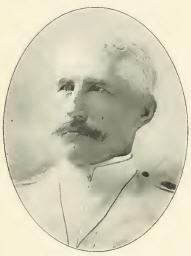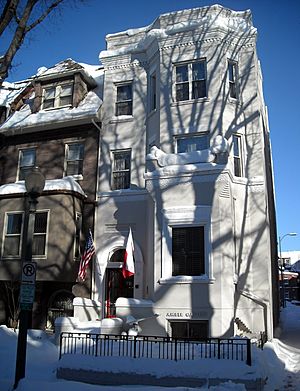Valery Havard facts for kids
Quick facts for kids
Valery Havard
|
|
|---|---|

Valery Havard
|
|
| Born | February 18, 1846 Compiegne, France |
| Died | November 6, 1927 (aged 81) mid-Atlantic Ocean |
| Allegiance | United States of America |
| Service/ |
United States Army |
| Years of service | 1871-1910, 1917-1923 |
| Rank | Colonel |
| Battles/wars | Spanish–American War Russo-Japanese War (military attaché) World War I |
| Other work | physician, author, and botanist |
Valery Havard (born February 18, 1846 – died November 6, 1927) was a very busy man! He was a career army officer, a doctor, a writer, and even a plant expert (a botanist). He held many important jobs during his time in the military. He is best known for his work in the western parts of the United States and in Cuba. Many plants in Texas are named after him, like the Chisos bluebonnet (Lupinus havardii), Havard oak (Quercus havardii), and Havard's evening primrose (Oenothera havardii).
Contents
About Valery Havard
His Early Life and Education
Valery Havard was born in Compiegne, a town in France. After finishing school at the Institute of Beauvais, he studied medicine in Paris, France. Later, he moved to the United States. He went to Manhattan College and also studied medicine at New York University in New York City. He graduated from both in 1869. For a while, he worked as a doctor at Children's Hospital. He also taught French, chemistry, and botany at Manhattan College.
Serving on the Frontier
In 1871, Valery Havard started working as a surgeon in the army. Three years later, he became a full assistant surgeon. In 1877, he spent six months with the 7th Cavalry in Montana. They were looking for Sioux and Nez Perce Indians.
In 1880, he joined the 1st Infantry. They were building roads in the Pecos River Valley in West Texas. In 1881, he went on an exploration trip into northwest Texas. He also went on other trips to the upper Rio Grande Valley in 1883 and 1884. During his time on the frontier, he became very interested in plants. He studied which plants Native Americans, Mexicans, and early settlers used for food and drink.
From 1884 to 1898, Havard worked at different army posts. These included places in New York, North Dakota, and Wyoming.
The Spanish–American War
When the Spanish–American War started in 1898, Havard became the chief surgeon for the Cavalry Division. He went with them to Siboney, Cuba. He worked in the field during the Battle of San Juan Hill on July 1. After the war, he joined General Leonard Wood's team in Havana. He was the chief surgeon for the Division of Cuba. He continued this role when Wood became the military governor. In October 1900, while in Havana, he got a serious case of yellow fever.
The Russo-Japanese War
After his time in Cuba, Colonel Havard returned to the United States. In 1904, he was sent to be a medical expert with the Imperial Russian Army during the Russo-Japanese War. Havard arrived in St. Petersburg, Russia, in December 1904. He reached the battlefront in Manchuria in February 1905. After being with the Russian forces for just over a month, Havard was captured by the Imperial Japanese Army at the Battle of Mukden. He was then sent back to the United States.
In his official report, Havard wrote down what he learned from the war. He noticed that new weapons, especially the machine gun, meant fewer head-on attacks. Armies had to move around the enemy more. This meant soldiers had to march longer distances and more often. In older wars, soldiers could rest at night, and fighting often stopped in winter. But in this war, attacks happened at night, and fighting continued even in very cold weather. Havard saw that soldiers were getting much more tired from battle. He also noted that bayonets (knives on rifles) became useful again for night attacks. The Japanese said that seven percent of their injuries came from bayonet wounds.
Because of what he saw, Havard suggested changes for the U.S. Army's Medical Corps. He thought the army should plan to train many medical workers for war. He also believed that civilian groups like the Red Cross were very important. Since modern weapons caused more injuries, Havard stressed that regular soldiers should be trained to help medical officers in field hospitals. He also talked about how important it was to have a good system to move injured soldiers from the battlefield to hospitals. He said that railroads were key for this. Havard also wanted hospitals to use telephone technology to get information quickly from the battlefront.
Later, he was chosen to be the president of the Association of Military Surgeons. In 1906, he became the president of the Army Medical School. He held this job until he retired from the military in 1910. After retiring, Havard moved to Fairfield, Connecticut. There, he continued to write, something he had started when he joined the army.
World War I Service
When World War I began, Colonel Havard was called back to duty. He helped the Cuban government reorganize the medical parts of its army and navy from 1917 to 1923. For this work, he received the Cuban Order of Military Merit award. In his 81st year, he died on a ship called the Columbo while returning from a visit to France.
His Writings
Valery Havard's first articles were about plants (botany) and staying healthy in the military. He later wrote reports about what he saw in the Spanish-American and Russo-Japanese Wars. In 1889, he published a "Manual of Drill for the Hospital Corps." He also won a prize in 1901 for his essay on how the U.S. Army's medical department could be best organized for war.
During his last time working in Washington, he published his "Manual of Military Hygiene" in 1909. He updated it with new editions in 1914 and 1917. At the time, this book was considered the best work on military health in the country.
Havard also wrote about the "French Half-breeds of the Northwest" in a report for the Smithsonian Institution in 1879. He published many articles about plants in Montana, North Dakota, Texas, and Colorado. These included "Botanical Outlines" in 1878 and "Report on the Flora of Western and Southern Texas" in 1885. His "Notes on Trees of Cuba" was published in 1901.
See also
 In Spanish: Valery Havard para niños
In Spanish: Valery Havard para niños


